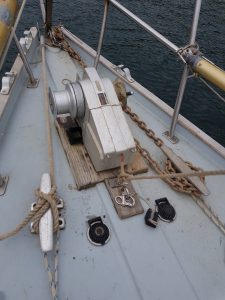That stands for Isle of Man Tourist Trial. The fastest and most dangerous road race in the world: Madmen on motorcycles flinging themselves around 37 miles of town squares and mountain roads at average speeds of 130 miles an hour. Top speed is over 200.
The “madmen” thing comes from the middle Sunday – “Mad Sunday” when anyone with a motorcycle can ride the course. The death toll since it started in 1907 has now reached 146.
So, I have come to the Isle of Man.
I happen to like motorcycles – I like the way they look. I like the way they sound – as long as they don’t disturb my peace and quiet – and there was a time when I owned a motorcycle: In my early 20’s, I had a BSA Bantam and came within an inch of killing myself in Streatham High Road.
… an inch each side, that is: That was the distance between the bike and the bus I was overtaking on one side and the oncoming lorry on the other.
I sold it soon afterwards and haven’t had one since. I’m quite dangerous enough in a car.
But, finding myself in Islay in the Hebrides and happening to see that the TT was about to start – and having nothing more than a vague plan to visit Dublin before I’m due in Pwllheli on June 8th – the chance was too good to miss.
Also, I needed to dry out against a convenient harbour wall to grease the feathering propeller and see to the anodes. The perfect place would be Ramsey on the island’s East coast: A drying harbour with three of the best spectator spots on the course – including Parliament Square. The idea of negotiating a town square and still keeping up the 136mph average would be something to see.
It was all settled: I could anchor overnight in the bay, enter the harbour at high water first thing in the morning and be up against the wall by lunchtime: Plenty of time to get the boatwork done and see something of the bikes.
You can guess by this stage, that something is going to go wrong.
First, the harbourmaster came round. He was a friendly chap and very helpful. One of the fishing boats had broken down and his mate was going out to get him – which meant that they would need some space to manoeuvre and would I move to a berth further down the quay?
No trouble at all – except neither of us appreciated that the water was a bit deeper there – and this being neaps. I had to creep around with it half way up my wellies.
While all this was going on, it started to rain – and of course, the TT death toll is quite high enough without allowing wet roads into the mix. So, practice was cancelled for the day.
Never mind, maybe Thursday’s session would go ahead. On the evening high tide, I moved out into the bay and anchored as close to the South West corner as I could get – the forecast being a brisk southwesterly.
Actually, I couldn’t get very close at all – the Isle of Man is one of those places where the beaches stretch for miles. It looked a long way in my tiny, lightweight inflatable dinghy – just 1.6metres long and weighing only 10kg. When I chose it, the idea was to inflate it in a trice and carry it around on my head. Now I fancied a big RIB with 30hp on the back.
All day the TT news played in Samsara’s cabin: Again, the afternoon practice was cancelled. Maybe they would resume at 1820.
At 1700, I inflated the dinghy. With the little 2.2hp outboard hammering for all it was worth into the wind, I set off for the beach.
Half-way there, I realised I hadn’t switched on the AIS*. It’s always a good idea to switch on the AIS when you leave your boat at anchor. Not only can you use your phone to check that she’s still there but if you search on this blog for a post called “Lost at Sea” you will learn how it saved me and my son Hugo one foggy day in Swanage – and if (unimaginably) the boat should drag her anchor and disappear out to sea, you can always charter a fishing boat and track her down.
Still, I was half-way there. Too bad…
The beach that had looked so welcoming through binoculars, now revealed itself as a quarter of a mile of wet sand – up which the water was advancing as if it wanted a race of its own. If I left the motor at the water’s edge and carried the dinghy above the high-water mark, the motor would be swamped by the time I got back to it.
If I took the motor first, the dinghy would float away…
The answer was to leap-frog them – 20 paces with the motor, then dash back for the dinghy, hoist it on my head and wobble hurriedly past the motor as far as I dared.
I have seen people in Africa carrying enormous loads on their heads. They all had perfect posture and seemed to know where they were going.
If I didn’t look down, I was going to trip over something. Add to that the fact that the dinghy’s 10kg is without the weight of the seat and the oars. By the time I reached the top and tied the painter to a stump, every time I turned my head, I could hear things creaking inside.
It was a mile to Parliament Square – and sure enough, there was a pub crowded with people in black TT racewear clutching pints of lager in plastic glasses.
Just to be sure (before I bought my own pint) I asked the nearest: “Is this a good place to watch?”
He turned from his beer: “It’s cancelled.”
“What? When did they cancel it?”
“About 20 minutes ago. We’d left our tent on the campsite. Got here and then we heard.”
A smattering of small raindrops blew into his plastic glass.
I had checked the five O’clock news before blowing up the dinghy. That was an hour and ten minutes ago.
So what was the good news?
The good news was that if I left the pub now and went straight back to the boat, I wouldn’t have to worry about her disappearing.
That was all yesterday. Today there is a 35kt wind blowing the rain sideways and whipping the half-mile fetch from the beach into the kind of waves that break on the bow and send spray onto the decks outside the heads window.
I’ve got a better idea: It’s due to drop tonight. I’ll leave for Dublin – plenty of pubs there…
*AIS – Automatic Identification System: A radio beacon broadcasting a vessel’s position and other details.
___________________________


 Homework
Homework





The road to ruin is paved with good intentions John – or ‘discretion is the better part of valour’ 🙂